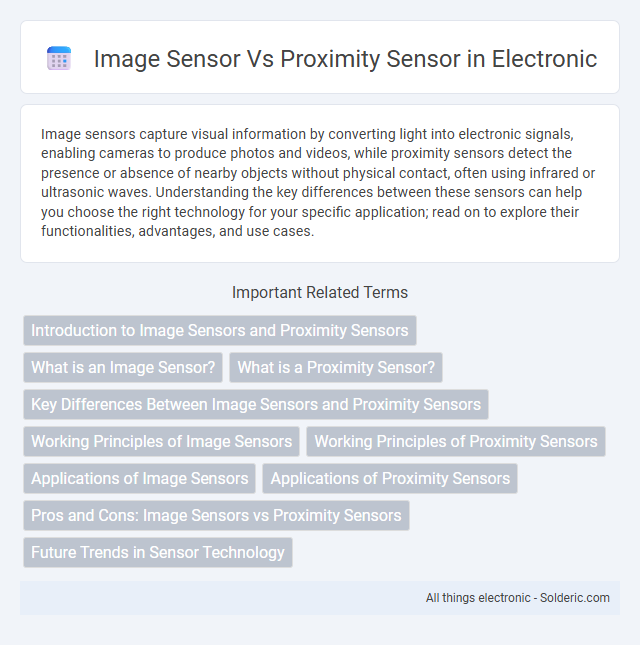Image sensors capture visual information by converting light into electronic signals, enabling cameras to produce photos and videos, while proximity sensors detect the presence or absence of nearby objects without physical contact, often using infrared or ultrasonic waves. Understanding the key differences between these sensors can help you choose the right technology for your specific application; read on to explore their functionalities, advantages, and use cases.
Comparison Table
| Feature | Image Sensor | Proximity Sensor |
|---|---|---|
| Function | Captures visual images by detecting light | Detects the presence or absence of nearby objects without contact |
| Working Principle | Converts light into electronic signals (CCD or CMOS) | Uses infrared, ultrasonic, or capacitive sensing technologies |
| Output Type | Digital image data | Binary or analog presence signal |
| Applications | Photography, machine vision, surveillance | Mobile phones, robotics, automated doors |
| Range | Varies, up to several meters depending on lens | Typically a few centimeters to a meter |
| Complexity | High processing requirements | Simple signal processing |
| Cost | Generally higher due to optics and processing | Lower cost and simpler design |
Introduction to Image Sensors and Proximity Sensors
Image sensors capture visual information by converting light into electronic signals, essential for cameras and optical devices, while proximity sensors detect the presence or distance of objects without physical contact, commonly used in automation and mobile devices. Your choice between an image sensor and a proximity sensor depends on whether visual data or object detection is required. Both sensors convert physical input into signals that enable smart interactions in various technological applications.
What is an Image Sensor?
An image sensor is a semiconductor device that converts light into electrical signals to capture visual information, primarily used in cameras and imaging devices. It consists of millions of photodiodes arranged in a matrix, each detecting light intensity to produce high-resolution images or videos. Unlike proximity sensors that detect object presence or distance through infrared or ultrasonic waves, image sensors provide detailed visual data essential for photography and computer vision applications.
What is a Proximity Sensor?
A proximity sensor detects the presence or absence of objects without physical contact, using technologies like infrared, ultrasonic, or capacitive sensing to measure distance or detect motion. Unlike image sensors that capture visual information through pixels, proximity sensors provide binary or distance-based feedback to control devices such as smartphones, automation systems, and robotics. Your devices rely on proximity sensors to enable features like screen activation and object detection, enhancing interactivity and safety.
Key Differences Between Image Sensors and Proximity Sensors
Image sensors capture and convert light into digital signals to create visual representations, primarily used in cameras and imaging devices. Proximity sensors detect the presence or absence of objects within a certain range without physical contact, utilizing technologies such as infrared, ultrasonic, or capacitive sensing. The key differences lie in their functions: image sensors focus on visual data acquisition, while proximity sensors are designed for object detection and spatial awareness.
Working Principles of Image Sensors
Image sensors operate by converting light into electrical signals through photodiodes arranged in a grid, capturing detailed visual information frame by frame. They utilize technologies such as CCD (Charge-Coupled Device) or CMOS (Complementary Metal-Oxide-Semiconductor) to process and convert incoming photons into digital images. This allows image sensors to deliver high-resolution, color-accurate representations crucial for cameras and visual detection systems.
Working Principles of Proximity Sensors
Proximity sensors operate by detecting objects without physical contact, using various principles such as electromagnetic fields, capacitance, or ultrasonic waves to sense nearby objects. Unlike image sensors that capture visual data through photodetectors, proximity sensors emit signals or fields and measure changes caused by objects within their range to trigger responses. Your choice between these sensors depends on whether you need visual information or simple object detection based on proximity.
Applications of Image Sensors
Image sensors are widely used in digital cameras, smartphones, and medical imaging devices to capture high-resolution visuals with accurate color reproduction. They enable advanced applications such as facial recognition, augmented reality, and machine vision in industrial automation. Compared to proximity sensors, image sensors provide detailed visual information essential for tasks requiring image analysis and pattern recognition.
Applications of Proximity Sensors
Proximity sensors are widely used in automotive systems for parking assistance and collision avoidance, industrial automation for object detection and process control, and consumer electronics such as smartphones for screen activation and gesture recognition. These sensors enable contactless detection of nearby objects, enhancing safety and efficiency in robotics and manufacturing environments. Their applications extend to security systems for intrusion detection and automated lighting control in smart buildings.
Pros and Cons: Image Sensors vs Proximity Sensors
Image sensors offer high-resolution visual data essential for applications requiring detailed image capture, but they consume more power and are costlier compared to proximity sensors. Proximity sensors provide reliable object detection without capturing images, making them energy-efficient and ideal for simple presence or distance measurement, yet they lack detailed information about the object's appearance. Your choice depends on whether detailed visual data or efficient object detection is the priority for your project.
Future Trends in Sensor Technology
Future trends in sensor technology highlight the increasing integration of AI and machine learning to enhance accuracy and responsiveness in both image sensors and proximity sensors. Image sensors are evolving with higher resolution and improved low-light performance, enabling more precise visual data capture for applications like autonomous vehicles and advanced robotics. Proximity sensors are advancing through miniaturization and multi-sensor fusion, allowing your devices to achieve faster and more reliable object detection in complex environments.
image sensor vs proximity sensor Infographic

 solderic.com
solderic.com